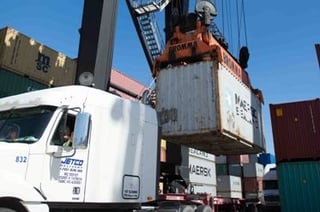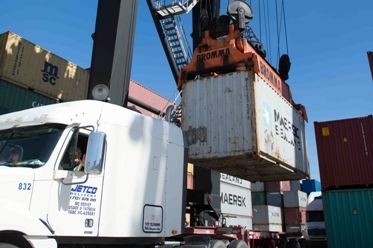What You Need to Know.
 The hot topic in the Texas shipping and logistics world is the changes in the state’s container weight laws. In every legislative session, proposals are made to increase legal weights for containerized cargo. Thus far, none have passed. In January, Brian Fielkow, Jetco CEO, outlined the case for and against increasing ocean-going truck weights from 80,000-84,000 pounds to 97,000 pounds gross vehicle weight. Having been TXTA intermodal chairman from 2011 to 2015, Brian has deep experience with this important issue and is recognized as an expert in this field. While many states already have higher container weights in place, Texas is considering the options when it comes to safety, jobs and the economy, and our infrastructure. And, opinions vary.
The hot topic in the Texas shipping and logistics world is the changes in the state’s container weight laws. In every legislative session, proposals are made to increase legal weights for containerized cargo. Thus far, none have passed. In January, Brian Fielkow, Jetco CEO, outlined the case for and against increasing ocean-going truck weights from 80,000-84,000 pounds to 97,000 pounds gross vehicle weight. Having been TXTA intermodal chairman from 2011 to 2015, Brian has deep experience with this important issue and is recognized as an expert in this field. While many states already have higher container weights in place, Texas is considering the options when it comes to safety, jobs and the economy, and our infrastructure. And, opinions vary.
Who do container weights affect? Everyone: shippers, trucking companies, the port, labor, CMV enforcement, local communities, steamship lines, federal and s
tate law makers, economic development advocates, infrastructure engineers and maintenance workers, chassis providers, rail, and, of course, our professional truck drivers.
As a starting point, a bill was introduced in the Texas legislature in 2015 to increase weights for ocean-going cargo to 97,000 pounds gross vehicle weight. The 2015 proposal sought to raise the container weights to 97,000 pounds: 20,000 lbs./axle; 40,000 lbs/tandem; 60,000 lbs. per tri axle. This would mean there would be routes to avoid – particularly defined bridges and roads that cannot handle this kind of weight.
We expect this bill (or something similar) to be raised in the 2017 legislature session. So, now is the time to start thinking about its implications. Here are the arguments that Brian presented in favor and against heavier container weights:
Safety
Proponents of heavier containers argue:
- Higher weights are not inherently unsafe. Permit loads tremendously in excess of 97,000# move on our roads every day. This is about driver certification, training and the right equipment.
- New truck technology makes heavier loads safer than ever (i.e. stability control)
- Other jurisdictions are reporting improved safety with laws authorizing heavier GVW’s. (Ex: Maine, UK)
- Weight distribution and axle weights are actually safer under the new proposal than the status quo.
- The 6th axle improves breaking capacity and reduces road wear due to a more even distribution of weight.
Opponents of heavier containers argue:
- Look at the reality of the Houston intermodal market. It is owner operator centric. New technology will not penetrate this driver pool for 10+ years.
- Permit loads are a small fraction of all loads that move in Texas. Can we as an industry really train the intermodal driver community to handle 97,000# safely?
- Maine is not Houston. Policy must be made based on the dynamics of our market (traffic, congestion, population, density).
- Diverse input is still required from multiple stakeholders.
- Steamship lines and international trade policy have developed new rules to limit container weights (SOLAS) as the result of safety concerns at the ports and over the water. Do heavier container weights over the road buck this trend?
Jobs and the Economy
Proponents of heavier containers argue:
- Because so many other jurisdictions offer heavy weights, we risk losing jobs and opportunity. The market is passing us by.
- The chronic driver shortage makes heavier containers weight necessary. We will not be able to keep up with projected volumes as they come on line.
- Don’t assume that resin producers are without options. They can produce resin in Houston and haul it out of our area.
- The logic that heavier containers results in fewer containers for the industry to haul is flawed due to growth assumptions that must be factored in.
Opponents of heavier containers argue:
- We’ve heard about the loss of freight to other jurisdictions, but where’s the proof? So far, it’s all hearsay. Houston is a geographically logical market for its trade lanes.
- Overweight containers actually could chase drivers from Houston drayage due to increased risk, equipment wear and tear and blow outs/down time.
- Heavier containers mask the real problems: driver pay, shipper flexibility on unloading hours/greater off-hours use of existing infrastructure, condition of pool chassis, and the need for grey pool.
- The Port of Houston Authority is already the #1 export port. Weight is obviously not the deciding factor.
Infrastructure
It comes down to some basic questions. The growth is on its way.
- What will take a greater toll on our roads?
- Relatively fewer trucks with 97,000# GVW and six axles, or
- Relatively more trucks with 80,000-84,000# GVW and five axles
- Will the $7,000/truck annual permit fee (proposed in the 2015 bill) cover increased wear and tear?
- Will the routing provisions such as those contained in the 2015 bill address bridge and roadway concerns?
- How can we quantify impact on infrastructure until we can project volumes and lanes?
Now is the time to educate yourself on what it means if a law is passed allowing heavier container weights. From safety, to jobs and our infrastructure, this debate has a great impact on Houston.



